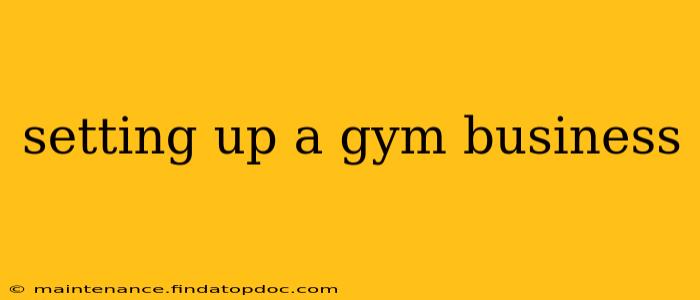Starting a gym business requires careful planning, substantial investment, and a deep understanding of the fitness industry. This comprehensive guide will walk you through the essential steps, from initial planning to ongoing operations, ensuring your gym thrives in a competitive market.
What are the initial costs of setting up a gym?
The initial costs of setting up a gym can vary significantly depending on several factors: location, size, equipment choices, and the level of luxury you aim for. Expect to invest in:
- Leasehold improvements: Renovations, flooring, painting, and any necessary structural modifications to your chosen space.
- Equipment: This is a major expense. Consider cardio machines (treadmills, ellipticals, stationary bikes), weight training equipment (free weights, weight machines), and functional training tools (kettlebells, resistance bands). Pricing depends on the quality and quantity you choose.
- Licensing and permits: These vary by location and may include business licenses, fitness instructor licenses, and health permits.
- Insurance: Liability insurance is crucial to protect your business from potential lawsuits.
- Marketing and advertising: Launching your gym will require investment in marketing materials, online advertising, and potentially grand opening events.
- Staffing: If you plan on hiring personal trainers, receptionists, or cleaning staff, factor in their salaries and benefits.
How do I find the right location for my gym?
Choosing the right location is paramount. Consider these factors:
- Accessibility: Select a location with ample parking, good public transportation access, and visibility from major roads.
- Demographics: Research the local population to ensure a sufficient number of potential clients live within a reasonable radius.
- Competition: Analyze the existing fitness facilities in the area to identify opportunities and avoid direct competition in a saturated market.
- Size and layout: The space should be large enough to accommodate your equipment, classes, and member traffic, while also allowing for a comfortable and efficient flow. Consider the placement of equipment for optimal workout flow.
- Lease terms: Negotiate favorable lease terms, including rent, length of lease, and renewal options.
What type of business structure should I choose for my gym?
Choosing the right business structure (sole proprietorship, partnership, LLC, etc.) is critical for legal and tax purposes. Consult with a legal and financial professional to determine the best structure for your specific circumstances. This will impact your liability and tax obligations.
What equipment do I need to start a gym?
The essential equipment depends on your gym's focus. However, a basic gym typically requires:
- Cardio equipment: Treadmills, elliptical trainers, stationary bikes, stair climbers.
- Strength training equipment: Weight machines, free weights (dumbbells, barbells), weight plates, benches.
- Functional training equipment: Kettlebells, resistance bands, medicine balls, battle ropes.
- Accessories: Mirrors, mats, towels, water fountains, and storage solutions.
How do I market my gym effectively?
Marketing is essential to attract and retain members. Utilize a multi-channel approach:
- Social media marketing: Build a strong online presence on platforms like Instagram, Facebook, and TikTok.
- Local advertising: Utilize flyers, local newspapers, and community events to reach your target audience.
- Website and online booking: Create a user-friendly website with online booking capabilities.
- Referral programs: Incentivize existing members to refer new clients.
- Grand opening promotions: Offer attractive introductory deals to attract initial members.
What are the legal requirements for opening a gym?
Legal requirements vary by location. You'll likely need:
- Business license: Obtain the necessary business licenses and permits from your local authorities.
- Insurance: Secure general liability insurance and potentially workers' compensation insurance.
- Health and safety permits: Comply with all health and safety regulations, including sanitation and emergency procedures.
How much does it cost to run a gym per month?
Ongoing monthly expenses include rent, utilities, staff salaries, equipment maintenance, cleaning supplies, insurance premiums, marketing, and accounting fees. Budgeting accurately for these recurring costs is vital for long-term financial stability.
How do I attract and retain gym members?
Attracting and retaining members requires a holistic approach:
- Excellent customer service: Provide a welcoming and supportive environment.
- Qualified trainers: Hire knowledgeable and certified personal trainers.
- Variety of classes: Offer a diverse range of classes to cater to different fitness levels and interests.
- Cleanliness and hygiene: Maintain a clean and hygienic facility.
- Community building: Foster a sense of community among members.
Starting a gym is a challenging but potentially rewarding venture. Through meticulous planning, careful execution, and a commitment to providing exceptional service, you can increase your chances of success in this competitive industry. Remember to constantly adapt and evolve your business model to meet the changing needs and preferences of your members.
